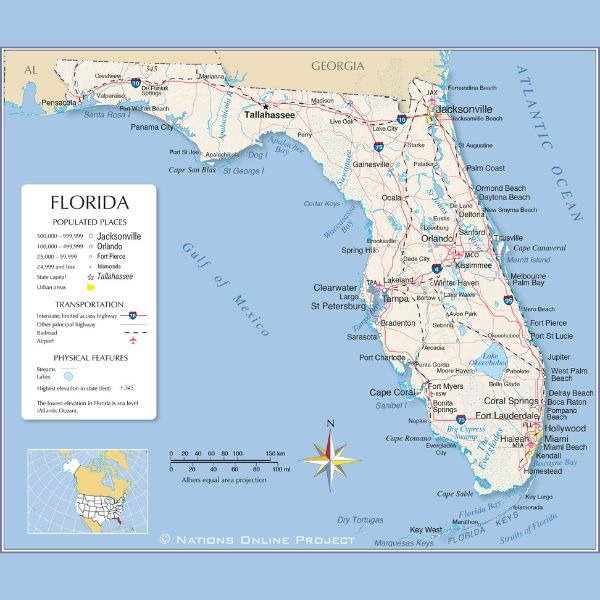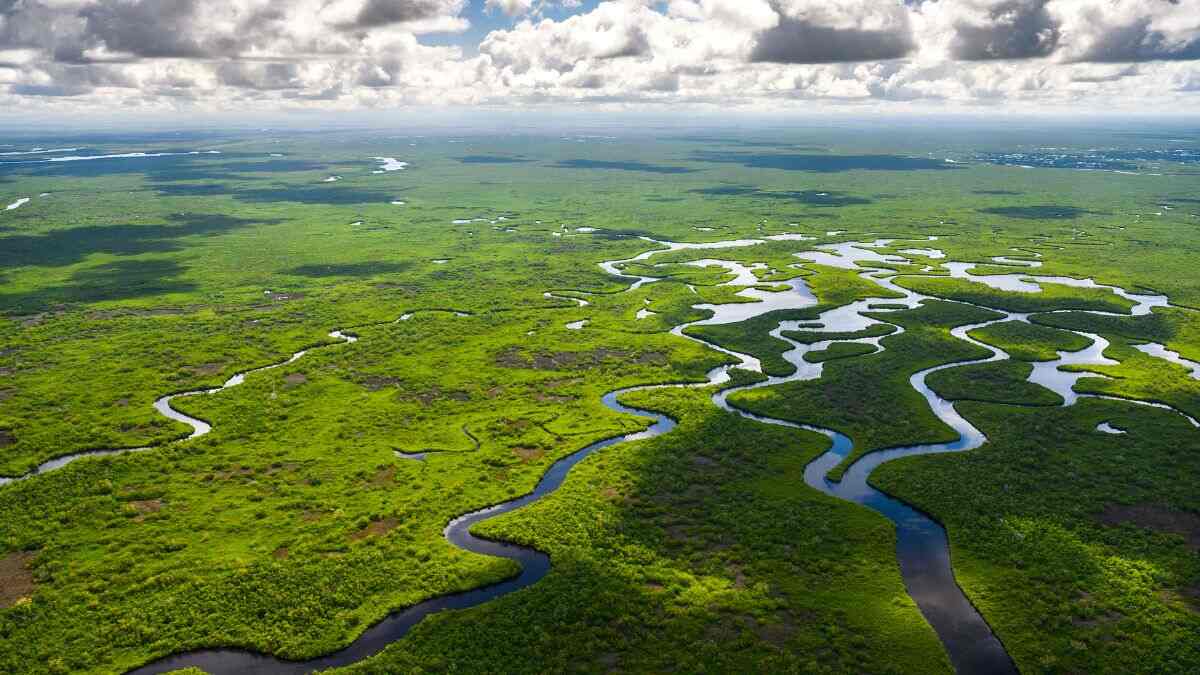Situated in the southeastern expanse of the United States, Florida stands as an internationally recognised state, earning the moniker "The Sunshine State." Spanning a lengthy, level peninsula, it stretches between the Atlantic Ocean to the east and the Gulf of Mexico to the west, with Alabama and Georgia flanking its northern borders.

Renowned for its appeal to tourists, this southeasternmost state boasts an array of captivating destinations. From the enchanting Walt Disney World to the awe-inspiring Cape Canaveral and the Kennedy Space Centre, the dynamic Universal Orlando Resort, the vibrant Miami Beach, the scenic Ten Thousand Islands, the unique Everglades, the historic Key West, and the picturesque Florida Keys. Ceded by Spain to the United States in 1819 under the name of Florida Territory, this region gained admission to the Union on March 3rd, 1845, securing its position as the 27th state.
ALSO READ| List of States in USA - Check How Many States in USA?
Florida Geographical Areas
Encompassing an expansive area of 170,304 square kilometres (65,755 square miles), the Florida peninsula is characterised by its abundant water resources, constituting over one-fifth of the state's total expanse. Florida boasts a remarkable presence of lakes, exceeding 12,000 square kilometres (4,700 square miles), with a substantial 7,700 lakes surpassing 4 hectares in size.
In terms of scale, Florida dwarfs its European counterpart, Austria, being slightly larger than twice its size. Furthermore, when juxtaposed with other states in the United States, Florida's dimensions reveal an interesting perspective — it could fit into the vast expanse of Texas more than four times over.
ALSO READ| Largest State in the USA by Population
Florida State Map
The comprehensive map presented below delineates the geographical features of the State of Florida in the United States.

Florida Map (Source| nationsonline.org)
It vividly illustrates the state's boundaries, pinpointing the capital city Tallahassee, major urban centres, populated areas, prominent rivers and lakes, extensive interstate highways, primary highways, railroad networks, and major airports within its expanse.
Cities And Towns
While Florida's topography may be predominantly flat, the state's geographical allure gains significant vibrancy from its rich features. Approximately 10,000 lakes punctuate the landscape, adding an intriguing dimension to what might otherwise be deemed monotonous. The Florida Keys, adorned with thousands of islands and islets, contribute a distinctive charm to the region.
Notably, Florida boasts the second-longest coastline in the entire United States, surpassed only by Alaska. Spanning an impressive length of 2,170 kilometres (1,350 miles), this extensive coastal stretch transforms the state into a vast and captivating beachfront, amplifying its appeal and character.
| Cities And Villages | ||||
| Apalachicola | Clearwater | Everglades City | Islamorada | Lakeland |
| Arcadia | Coral Springs | Fernandina Beach | Jacksonville | Largo |
| Avon Park | Crestview | Fort Lauderdale | Jacksonville Beach | Leesburg |
| Bartow | Dade City | Fort Myers | Jupiter | Live Oak |
| Belle Glade | Daytona Beach | Fort Pierce | Kendall | Madison |
| Boca Raton | De Funiak Springs | Fort Walton Beach | Key Largo | Marathon |
| Bonita Springs | De Land | Gainesville | Key West | Marianna |
| Bradenton | Delray Beach | Hialeah | Kissimmee | Melbourne |
| Brooksville | Deltona | Hollywood | Lake City | Merritt Island |
| Cape Coral | Eustis | Homestead | Lake Wales | Miami |
| Palatka | Punta Gorda | Pahokee | Port St Lucie | Ormond Beach |
| Orlando | Port Charlotte | Miami Beach | Palm Bay | Port St Joe |
| Okeechobee | Pompano Beach | Ocala | Perry | Sanford |
| Moore Haven | Palm Coast | Naples | Panama City | Sarasota |
| New Smyrna Beach | Pensacola | Sebring | West Palm Beach | Tallahassee |
| St Augustine | St Petersburg | Spring Hill | Winter Haven | Starke |
| Tampa | Vero Beach | Valparaiso | Titusville | |
Florida’s World Heritage Site
Within the bounds of Florida lies a distinguished UNESCO World Heritage Site, situated at the southern tip of the peninsula—the expansive Everglades. As the largest designated subtropical wilderness reserve on the North American continent, the Everglades National Park stands as a testament to the region's ecological richness.
The official website of the Everglades National Park beckons visitors to explore its diverse landscapes, featuring wetlands adorned with both fresh and brackish water, shallow bays, deeper coastal waters, tropical hammocks, and thriving rainforests. This unique habitat hosts the largest mangrove ecosystem in the Western Hemisphere, creating a haven for a myriad of bird and reptile species, including the protection of threatened animals such as the manatee.

Regrettably, the park has unwittingly become a sanctuary for non-native species, presenting a significant and escalating challenge to its ecological integrity. The degradation of the property, resulting in the loss of marine habitat and a decline in aquatic species, led to the Everglades being placed on the List of World Heritage in Danger in 2010.
Foremost among the threats faced by the Everglades National Park is the diversion of water to the continually expanding metropolitan areas in South Florida. This diversion poses the primary menace to the park, jeopardising its delicate ecological balance and compelling the need for concerted conservation efforts to ensure the preservation of this invaluable natural treasure.
ALSO READ| List of Most Powerful Military Forces in the World 2024
Florida Population
As of the latest estimate in 2024, Florida is home to a thriving population of 22.9 million people, solidifying its status as the third most populous state in the United States. California and Texas precede it in population size. The state capital is Tallahassee, while the distinction of being the most populous city belongs to Jacksonville, boasting a population of 880,000 residents.
The Miami-Fort Lauderdale-Pompano Beach metropolitan area stands out as the most densely populated, accommodating a bustling community of 5.5 million individuals. Other major urban centres contributing to the state's dynamic demographic landscape include Miami, Tampa, Orlando, St. Petersburg, and Hialeah.
In terms of spoken languages, the linguistic fabric of Florida reflects its diverse population. English takes precedence as the predominant language, spoken by 75% of the residents. Additionally, the influence of Spanish is significant, with a notable 19% of the population conversant in the language, highlighting the state's cultural and linguistic diversity.
Comments
All Comments (0)
Join the conversation